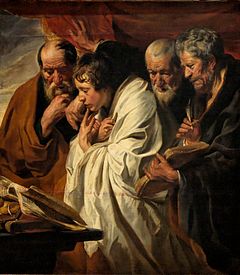- Gospel harmony
-
This article is about attempts to merge, or harmonize, the Christian canonical gospels. For harmony in Christian Gospel music, see Gospel music.
A Gospel harmony is an attempt to merge or harmonize the canonical gospels of the Four Evangelists into a single gospel account, the earliest known example being the Diatesseron by Tatian in the 2nd century. A gospel harmony may also establish a chronology for the events of the life of Jesus depicted in the four canonical gospels and how they relate to each other. Under modern scholarship, the effort has waned to portray any one harmony of events as totally correct[citation needed]. The process can also be hindered by discrepancies between various Gospels accounts of certain events.
The unique material of each gospel complicates the discernment of one, harmonized chronology. However, some consider the unique material crucial to narrowing down the possible chronological order. Some[who?] scholars have questioned the historicity of events in the canonical gospels.
Contents
Approaches to harmony
The terms harmony and synopsis have been used to refer to approaches that aim to achieve Gospel harmony, although they are different approaches. Technically, a "harmony" weaves together sections of scripture into a narrative, merging the four Gospels. There are four main types of harmony: radical, synthetic, sequential and parallel. A "synopsis", much like a parallel harmony focuses on key events and brings together similar texts or accounts in parallel format, usually in columns.[1]
 Gospel of Mark, Book of Durrow, 7th century.
Gospel of Mark, Book of Durrow, 7th century.
Tatian's Diatesseron harmony which dates to about 160AD was perhaps the very first harmony. In the 3rd century the Christian Ammonius of Alexandria developed the forerunner of modern synopsis as the Ammonian Sections in which he started with the text of Matthew and copied along parallel events. In the 5th century, Saint Augustine wrote extensively on the subject in his book Harmony of the Gospels.[2] No other major Gospel harmonies appeared thereafter until the 15th century.
The 16th century witnessed a major increase in the introduction of Gospel harmonies. In this period the parallel column structure was introduced, partly in response to the rise in Biblical criticism. This new format was used to emphasize the trustworthiness of the Gospels. It is not clear who produced the very first parallel harmony, but Charles Dumoulin in 1565 and Gerhard Mercator in 1569 had used similar approaches. In terms of content and quality, Johann Jacob Griesbach's 1776 synopsis was a notable example.
In the 19th century, other "extract and merge" attempts were made, which were not technical harmonies, e.g. the 1819 Jefferson Bible which placed selected verses in chronological order, but removed large sections of text that Thomas Jefferson considered too supernatural.
W. G. Rushbrooke's 1880 Synopticon is at times considered a turning point in the history of the synopsis, for it was based on Markan priority, i.e. giving priority to the Gospel of Mark. Thirteen years later, John Broadus used historical accounts to assign priorities in his harmony, while previous approaches had used feasts as the major milestones for dividing the life of Christ.
Two separate books, both titled Synopsis of the Four Gospels, one by Kurt Aland[3] and the other by John Bernard Orchard,[4] are considered by some to be the standard texts in the field of Gospel harmony since the 20th century.[5] In 2006, Gregg Zegarelli published a harmony with an extensive numbering reference system to track the harmonization process.[6]
A parallel harmony presentation
- For a visual representation of the events, please see: Gospel harmony gallery
The following table, mainly events for which there is also a Wikipedia article, is an example of a parallel harmony, based on the list of key episodes in the Canonical Gospels. The order of events, especially during the ministry period, has been the subject of speculation and scholarly debate. While this harmony compares the work of several scholars, other harmonies may differ substantially on the placement of some events. The episode structure within the table is based on Edward Robinson's A Harmony of the Gospels in Greek as well as Steven L. Cox and Kendell H Easley's Harmony of the Gospels.
See also
- Chronology of Jesus
- Life of Christ
- List of key episodes in the Canonical Gospels
- List of New Testament stories
- Ministry of Jesus
- Timeline of the Bible
References
- Orville Daniel: A Harmony of the Four Gospels, 2nd Ed, Baker Books Pub.
- R. Thomas & S. Gundry: The NIV Harmony of the Gospels, HarperCollins Pub.
- Edward Robinson: A Harmony of the Gospels in Greek, Revised Ed, pub. by Crocker & Brewster
- Henry Rutter, Evangelical harmony Keating and Brown, London 1803.
- Steven L. Cox, Kendell H Easley, 2007 Harmony of the Gospels ISBN 0-8054-9444-8
Notes
- This article incorporates work from A Harmony of the Gospels in Greek by Edward Robinson, a publication now in the public domain.
- ^ Steven L. Cox, 2007 Harmony of the Gospels B&H Publishing ISBN 0-8054-9444-8 page 3
- ^ Augustine through the ages: an encyclopedia by John C. Cavadini 1999 ISBN 080283843X page 132
- ^ Kurt Aland, 1982 Synopsis of the Four Gospels United Bible Societies ISBN 0-8267-0500-6
- ^ John Bernard Orchard, 1983 Synopsis of the Four Gospels T&T Clark Publishers ISBN 0-567-09331-X
- ^ Steven L. Cox, Kendell H Easley, 2007 Harmony of the Gospels ISBN 0-8054-9444-8 pages 7-8
- ^ Gregg R. Zegarelli, 2006, ONE OUG Press Publishers ISBN 978-0-9789906-0-2
External links
- Augustine's Harmony of the Gospels
- Parallel Gospels in Harmony (broken link) Online version of Parallel Gospels in Harmony: with Study Guide, by David A. Reed, a public domain book
- Complete Gospel texts, shown in four parallel columns, but not a harmony
Categories:- 1st-century Christianity
- Chronology
- Christian terms
- Gospel episodes
- Biblical paraphrases
- Lists of stories
- Canonical Gospels
Wikimedia Foundation. 2010.

